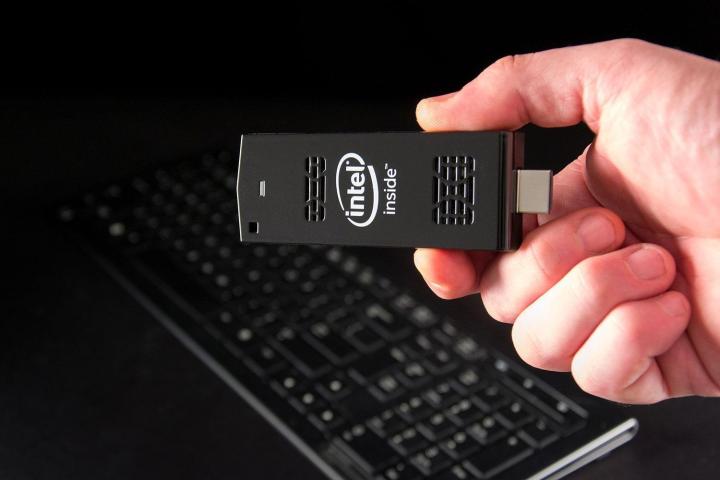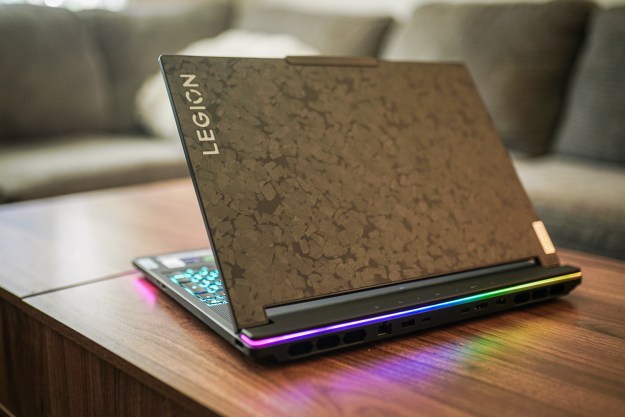
Indeed, it may well be that the laptop continues to be the standard in portable computing for years to come. That being said, the combination of advances in technology and users growing more accustomed to alternative devices makes for an appealing gap in the market.
As such, manufacturers continue their attempts to carve out a new niche, and in doing so find the next big thing. We won’t know what that product is until it’s been broadly adopted by consumers — but it seems many major players expect it to be the stick PC.
A PC in your pocket
The basic concept of a stick PC isn’t too complex; it’s a self-contained computer that resembles a standard USB flash drive in terms of form factor. However, the standard stick PC is built around a HDMI connector, rather than a USB input.
This allows the device to be connected directly to any display with a HDMI port, which is pretty standard on most modern monitors and televisions. Portability is key to the appeal of the stick PC — if you can be confident that you’ll find a HDMI-enabled display wherever you might want to use the device, why lug around a laptop with a bulky display?

Once you plug your stick PC into an appropriate display, it functions much like any other PC. Don’t expect a rig capable of playing the latest video games or indulging in other high-intensity usage, as these are devices running on an Atom processor and a couple of gigabytes of RAM, but basic computer functionality is no great struggle.
The biggest drawbacks to the stick PC are a lack of performance and some issues with connectivity. You can chalk up these issues to the relative immaturity of the device — Intel’s Compute Stick is arguably the biggest name on the scene, and it only launched as recently as April of this year.
Since then, a host of smaller manufacturers and some major players in the computing industry have made their own plans to corner the market for stick PCs. However, it’s unlikely that Intel is too put out by the increase in competition, as all their rivals are using the company’s Atom processors.
Back in June, Lenovo announced plans for the Ideacentre Stick 300, a device that boasts a small speaker as its unique selling point. Just this past week, the VivoStick turned out to be one of the more talked-about products that Asus brought to IFA 2015.
Interest in stick PCs certainly seems to be growing, both in terms of manufacturers and consumers. The question is, how are these devices going to offer something that other products cannot?
A two-way street
There’s a certain novelty factor to the stick PC, as having a fully-functional computer clipped to your keyring sounds more like a gimmick from the Jetsons than something you can order today for less than $150. However, that doesn’t mean the device doesn’t have some powerful real-world applications.
At their current price point, it’s safe to say that stick PCs aren’t in the exact same marketplace as a streaming device like the ChromeCast or a Kindle Fire TV Stick. However, given that a device like the Compute Stick can serve the same purpose while offering a great deal more functionality, the price difference might turn out to be less of a gulf than it seems.

Anyone working in a well-equipped office might look at the stick PC as a no-brainer method of bringing materials to a presentation, safe in the knowledge that they’ll be able to access them as intended so long as there’s a display with a HDMI port on offer.
It might also appeal to the student who has access to countless screens on campus, but would appreciate the practicality of saving all their work to a physical device so they can work on it while they’re at home.
Elsewhere, a business might find that the best way of running an advertisement or information board is via a stick PC. After all, it’s cheap enough, reliable enough and flexible enough to display any of the content they might be looking to offer up, but its set-up requires less knowledge and effort than an Xbox or a Blu-ray player.
Stick PCs fill a variety of niches, but crucially they do so without any changes to the base product. One user might put it to work in a completely different way to another, but nothing about the device itself has to be changed.
A device like the Compute Stick might be a souped-up streaming solution to one consumer, a study aid for the next and a business solution to another — but the company behind it only has to manufacture one product.
Whether the general public has its interest piqued by stick PCs remains to be seen, but they’re too good of a proposition for manufacturers to pass up. There’s a good reason that so many companies are launching their own devices of this ilk, and it’s because they can be targeted at just about any audience and still offer something of value.
Where’s my mouse and keyboard?
There is, however, one thing impeding the stick PC as it stands. The fact that these devices are ultra-portable is a solid selling point, and compatible displays are plentiful — but you might have more difficulty finding a spare keyboard and mouse lying around.
Whether or not manufacturers can tend to this problem could well decide the fate of the stick PC as a whole. However, the solution may be in user’s pockets already. A smartphone app could offer a virtual trackball and keyboard, the convenience of which would make up for any inaccuracy.
Stick PCs aren’t intended for activities like online multiplayer in your favourite FPS or pixel-perfect photo manipulation in Photoshop. A virtual input method isn’t sufficient in many cases, but for the simple tasks like basic navigation, web browsing and word processing, it would likely do the job. The Smartglass app used in conjunction with an Xbox One is a good demonstration of how natural smartphone controls can feel.
Whatever the solution is to the problem of interacting with your stick PC, it’s something that needs to be considered before these devices can truly fulfil their potential. With every accessory that you need to take with you, the appeal of these computers diminishes, so it will take some lateral thinking to uncover the correct course of action.
There’s a bright future ahead of these computers, if the downsides of the first generation of devices can be addressed. After all, there was a time when portable computers like laptops and tablets seemed a fad. The shock of the new might cause some to turn their nose up at a PC the size of a thumb drive, but by this time next year, these ultra-small devices might have carved out a new type of computing.
Editors' Recommendations
- Watch this BBC report about computer addicts … from 1983
- Intel’s new CPU feature boosted my performance by 26% — but it still needs work
- Qualcomm just made some bold claims about gaming on ARM PCs
- OneDrive is ruining my PC gaming setup
- One of the great rivalries in PCs could collapse


